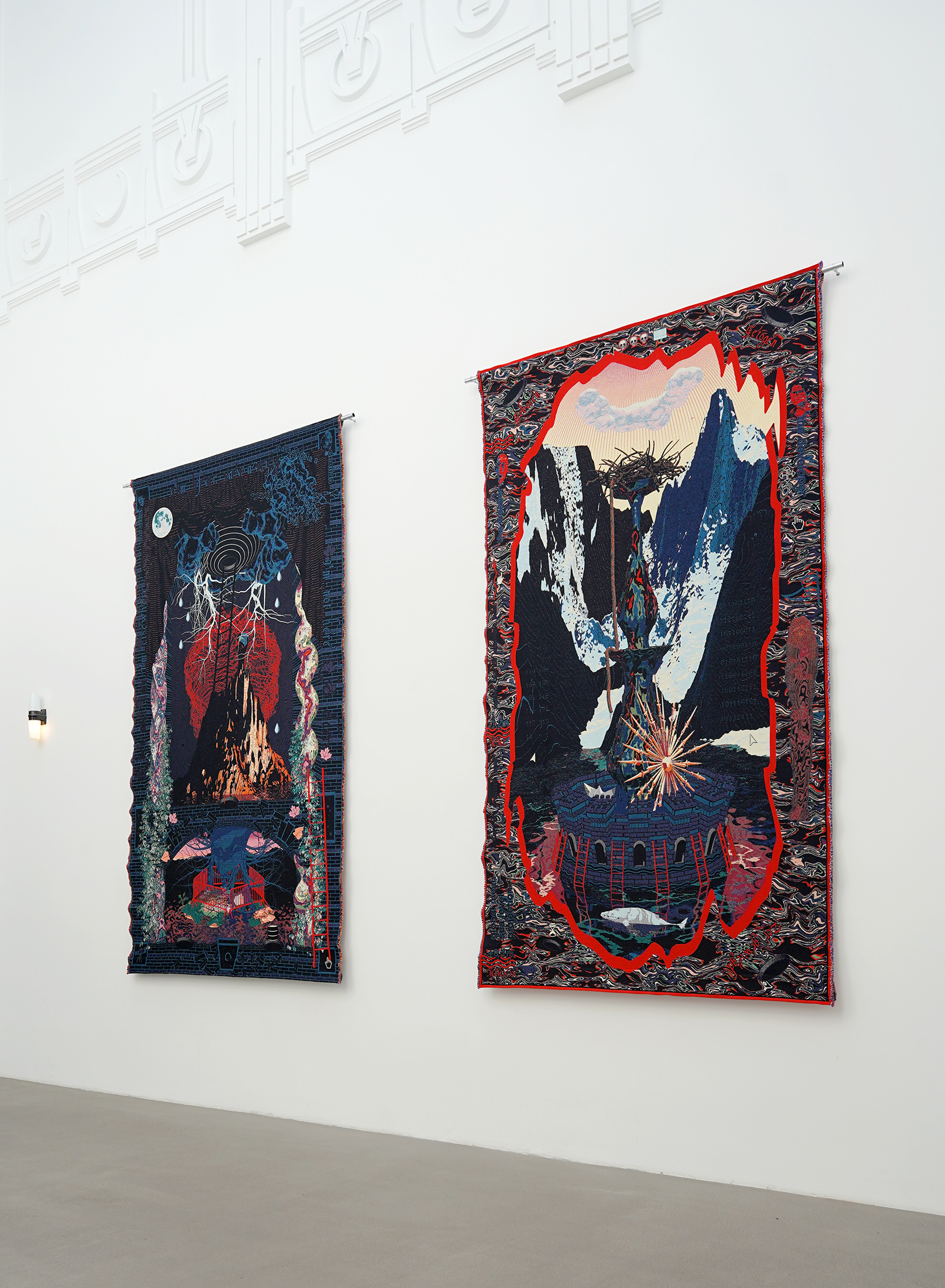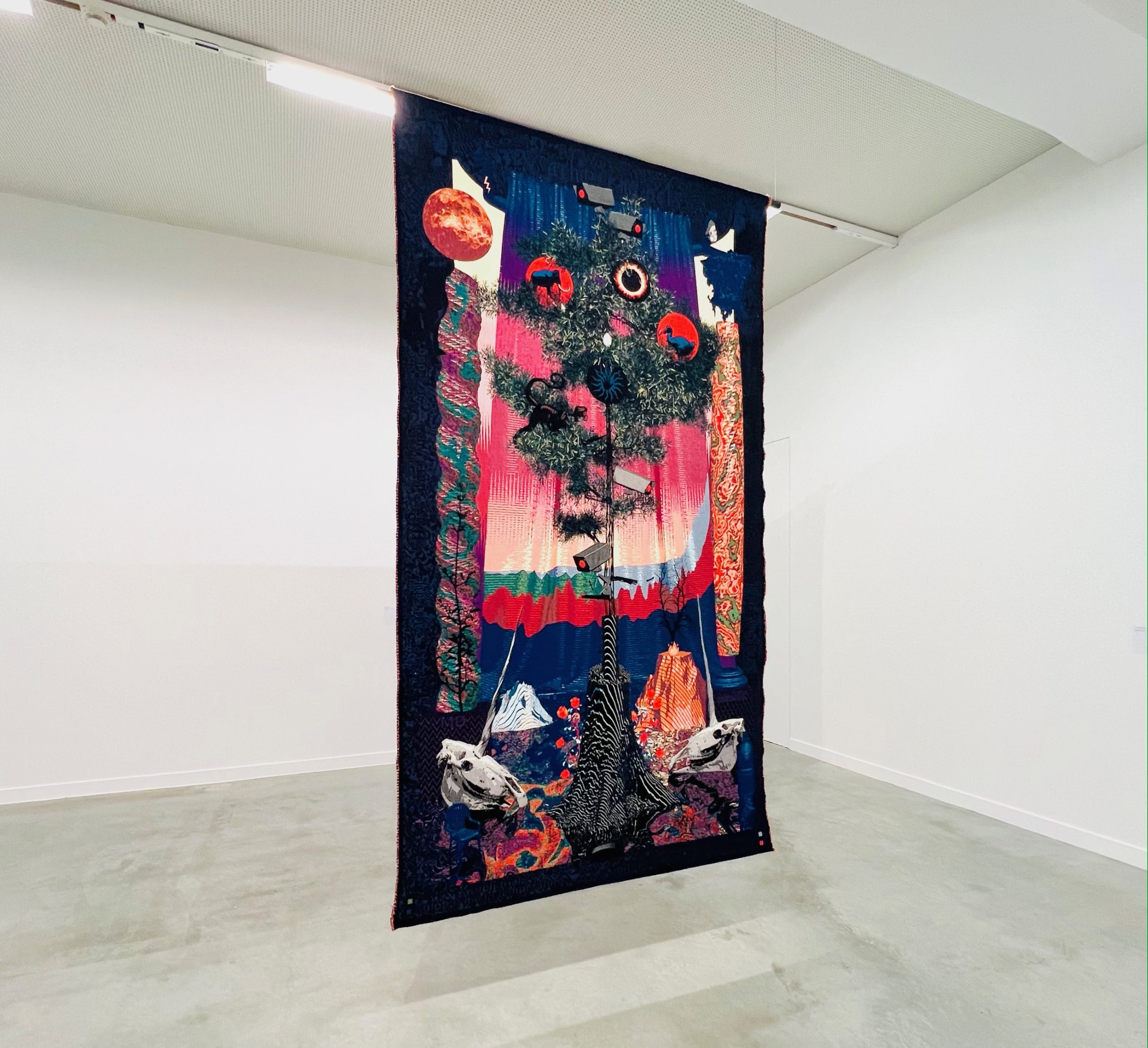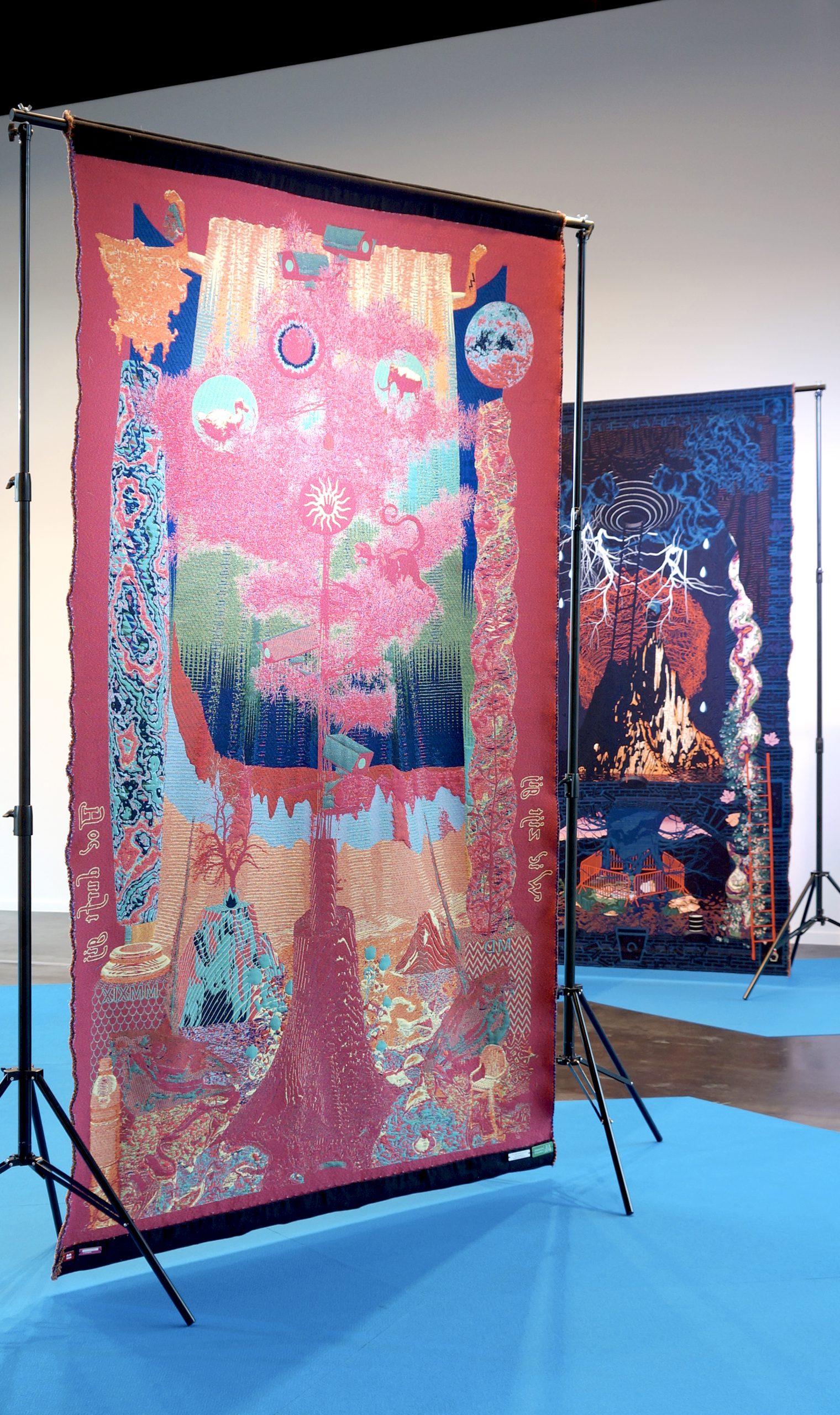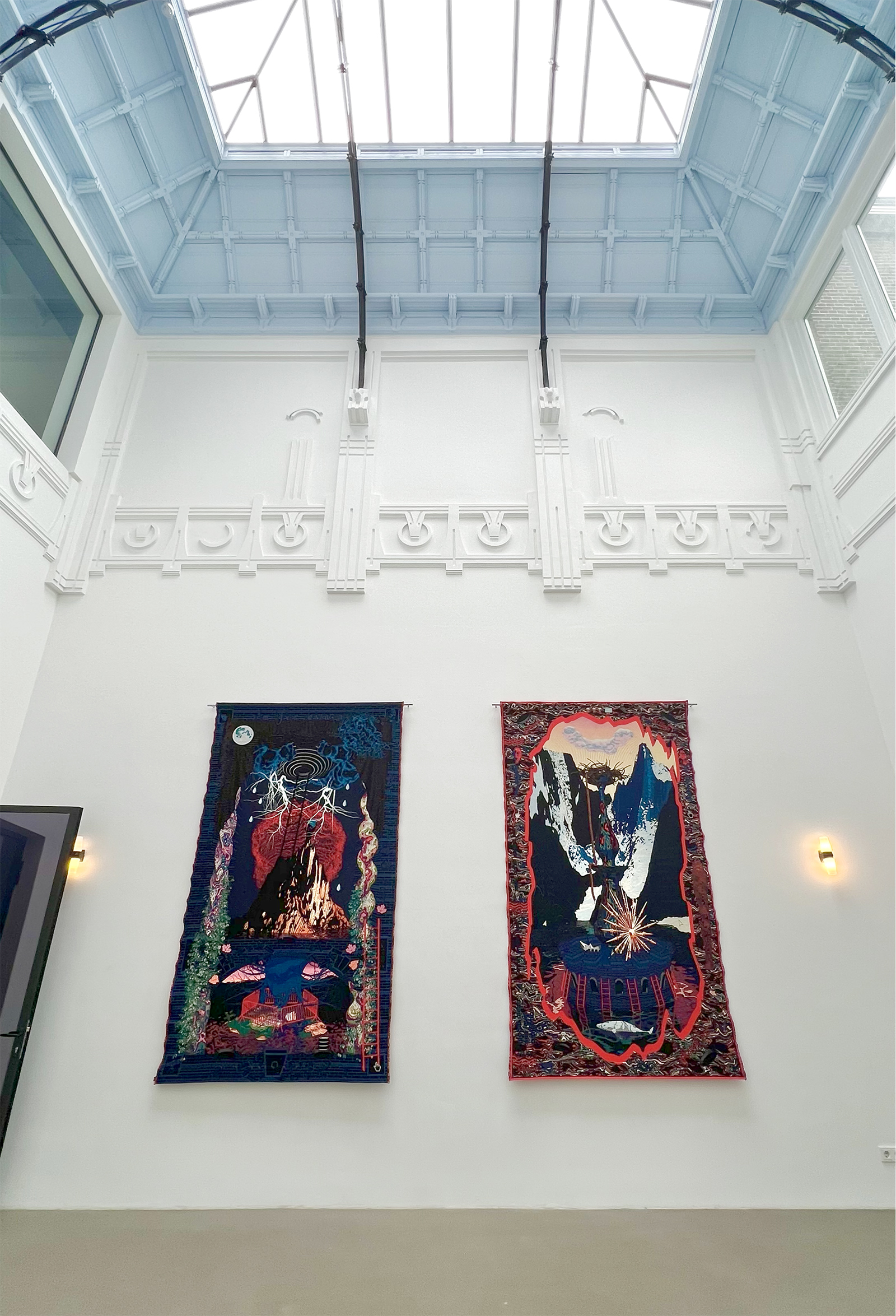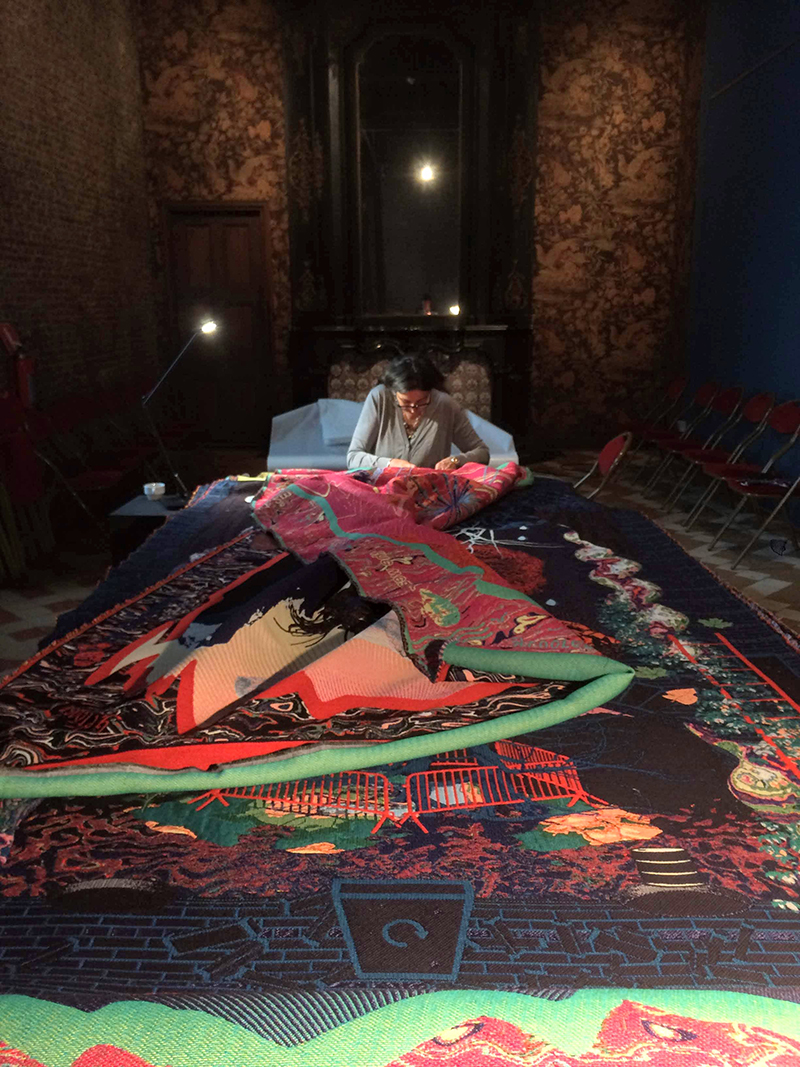The Three Motions of Loom
Three gobelin woven tapestries, (organic) cotton, wool, viscose, acrylic, 162 x 296cm, 2019. Edition of 3.
The three tapestries of The Three Motions of Loom departed from two fragments of Wildevrouw, Belgian author Jeroen Olyslaegers’ novel-to-be (publication by De Bezige Bij in December 2020).
Wildevrouw is set in 16th century Antwerp, on the verge of the Middle Ages and modernity. At the time, The Southern region of The Netherlands was the epicenter of the tapestry industry.
The automatic weaving machine, programmed by punch cards, was the predecessor of the computer.
In the designs, parts of Olyslaegers’ texts, and hints for future art historians are hidden.
The tapestries were woven at the Textiellab of Textielmuseum Tilburg, with financial support by deBuren (Grensverleggers project), and Kunstloc Brabant’s impulsgelden.
Many thanks to developer Marjan van Oeffelt, confectionist Annet Sunderman, Base-Alpha Gallery, Museum Vleeshuis, Bas Veldhuizen, and many more.
The Three Motions of Loom
Fundamental Mechanics, Let off and Take up, Brake
The Three Motions of Loom
Fundamental Mechanics, Let off and Take up, Brake
Een donderpreek. Zo herinner ik mij Jeroen Olyslaegers’ voordracht van de eerste fragmenten uit zijn Wildevrouw manuscript, in mei 2018. Het publiek was doodstil terwijl de protagonist van zijn geloof viel, en de schrijver ons transporteerde naar de straten van het 16e eeuwse Antwerpen.
Mijn werk beweegt zich als een schietspoel tussen het diepe verleden en wat nog kan komen. Ik verbind prehistorische stenen werktuigen met mijn computermuis, en denk na over mogelijke toekomsten, over de wereld na de mens, over technologie en over onze gecompliceerde relatie met natuur. Jeroen’s tekst is een draad naar een periode, nog maar zo kort geleden, waarover mijn kennis oppervlakkig was. Ik wilde een tijd lang in de 16e eeuw zijn.
Ik week niet alleen af van mijn gewoonlijke route door de tijd, maar ook van mijn gebruikelijke media: de onstoffelijke digitale wereld van animaties en tijdelijke in situ installaties. Er moesten wandkleden worden geweven; het kon niet anders.
Het vroegste geautomatiseerde proces gebruikte de jacquard weefmachine, die werd aangestuurd door geperforeerde kaarten op rollen. Ponskaarten waren de eerste computerprogramma’s. In de 16e eeuw waren de zuidelijke Nederlanden het epicentrum van de wandkleden-industrie. Brusselse en Oudenaardse wandkleden hingen in elk zichzelf respecterend kasteel of stadhuis in Europa.
Een wandkleed is decor, het isoleert, dempt geluid, en is eenvoudig te transporteren. Meer dan een jaar lang zag ik bijna alleen maar 16e eeuwse kunst uit deze regio. Ik legde virtuele verzamelingen aan. De beeldcultuur van de 16e eeuw is niet te vangen: ze begint met het einde van de Middeleeuwen, met de Vlaamse Primitieven en hun rokken en gordijnen, plooiend als plaatijzer. De Renaissance trekt, samen met het mathematisch perspectief, vanuit Italië naar het Noorden. De eeuw eindigt met de barok: lendendoeken wentelen in windkracht 10, een storm die de moderniteit met zich meedraagt.
Als we naar 16e eeuws beeld kijken, kijken we 450 jaar terug in de tijd. Het is onmogelijk om de rijkdom van betekenis en wereldbeelden uit die uiteenlopende kunstproductie te ontrafelen. Ik vroeg me af of ik kon voorspellen hoe actuele kunst – mijn werk, nu – 450 jaar verder in de toekomst zal worden gelezen. Daarom zijn niet alleen Jeroen’s woorden verweven met de wandkleden, maar werden ook temperatuur- en CO2 grafieken en de verwachte zeespiegelstijging erin verwerkt, samen met visuele verwijzingen naar digitale beeldtaal, elementen uit historische wandkleden, en portretten van betrokkenen bij het project. Zo heeft de toekomstige toeschouwer genoeg stof tot interpretatie.
A thunderous speech. That’s how I remember Jeroen Olyslaegers’ recital, in May 2018, of the first fragments from his Wildevrouw manuscript. The audience was holding its breath while the protagonist fell from faith, and the writer transported us to the streets of 16th century Antwerp.
My work shuttles between the Distant Past and the Far Future. I connect prehistoric stone tools to my computer mouse, and think about possible things to come, about the world after humans have disappeared, about technology, and about our complicated relationship to nature. Jeroen’s text made me follow a thread to an era, not too long ago, of which my knowledge was still superficial. I longed to linger in the 16th century, if only for a while.
I didn’t only deviate from my usual route through time, but also from my artistic weapons of choice: the immaterial world of animations, and temporary in situ installations. Tapestries had to be woven: there was no other option.
The first programmable mechanism was a loom, controlled by perforated cards. Punch cards would command the first computers.
In the 16th century the southern Netherlands were the epicenter of the woven tapestry industry. Tapestries made in Brussels or Oudenaarde could be found all over Europe in any respectable castle or city hall. A tapestry is decor, it isolates, improves acoustics, and is easy to transport.
For over a year, all I would look at was 16th century art works from this region. I started virtual collections. 16th Century visual culture is hard to define: it starts with the end of the Middle Ages, with the Flemish Primitives and their skirts and curtains folding like sheet iron. The Renaissance moves from Italy to the North, bringing mathematical perspective that enables advanced visual illusions. The century ends with Baroque: loincloths weaving in 10 Beaufort, a storm that carries modernity.
When we look at 16th century images, we look 450 years back in time. It’s virtually impossible to unravel the wealth of meaning in this divergent art production. I wondered if I could predict how current contemporary art – my works, now – would be interpreted in 450 years time. Therefore not only Jeroen’s words are woven in the tapestries, but also temperature- and CO2 graphics, the predicted sea level rise, and an arsenal of visual references to the digital world, elements from historical tapestries, and portraits of people involved in the project. This way, the future onlooker is being put to work: there’s a lot to interpret and decode here.
Decoding The Three Motions of Loom
Below three images decoding elements in the tapestries; a viewer’s guide.
Press
A conversation with Pieter Vermeulen, h ART #200.
Exhibitions
- Museum Vleeshuis, Antwerp, Belgium
- Antwerp Art Pavilion (MAS), Belgium
- miXmass, deSingel, Antwerp, Belgium
- Point of No Return, CC Ekeren, Belgium
- Collectie De Groen, Arnhem, Netherlands
- Museum M, Leuven, Belgium
Collections
The Gij, Wildeman edition is in the collection of
- British Library, London, UK
- Hendrik Conscience Heritage Library, Antwerp, BE
- Royal Library of Belgium, Brussels
- Royal Library, The Hague, NL
Relevant Links
- Wildevrouw collection on Pinterest.
- Fundamental Mechanics
- Fundamental Mechanics (NFT series)
- 195.100.000 Views
- Gij, Wildeman
Notes:
The use of Pinterest as an online archive involved a mild case of machine learning: by continuously bypassing the websites suggestions focused on finding images concerning crafts, fashion and interior design, after some time I managed to get useful – to me – and more obscure results from the Pinterest internet image crawler.
While working on Fundamental Mechanics, I set up a Giphy account (defunct since May 2020) under the username Denkbaar. Anyone could use these GIF stickers in their Instagram stories or elsewhere online.
Gij, Wildeman contains the text Olyslaegers gave me, and a double-sided woven work – see below – by me. The edition is published by Demian, Antwerp.


